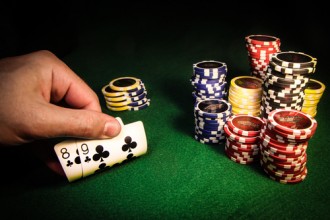
December 28, 2018
A Patent on Games? No Dice.
In In re Marco Guldenaar Holding B.V., [2017-2465] (December 28, 2018), the Federal Circuit affirmed the decision of the PTAB, which affirmed the rejection of claims 1–3, 5, 7–14, 16–18, and 23–30 of U.S. Patent Application No. 13/078,196 under 35 U.S.C. § 101 for claiming patent-ineligible subject matter.
The application, entitled “Casino Game and a Set of Six-Face Cubic Colored Dice,” relates to dice games intended to be played in gambling casinos in which a participant attempts to achieve a particular winning combination of subsets of the dice.
The Examiner concluded that the claims were directed to the abstract idea of “rules for playing a game,” which fell within the realm of “methods of organizing human activities.” The examiner also concluded that the claims were unpatentable for obviousness over U.S. Patent No. 4,247,114 over matters old and well known to dice games, applying the printed matter doctrine. The Board affirmed both rejections.
The Federal Circuit found its decision in In re Smith, 815 F.3d 816 (Fed. Cir. 2016), where it found a method of conducting a wagering game using a deck of playing cards was drawn to an abstract idea, to be “highly instructive.” In the present case, as in In re Smith, the claims were directed to a method of conducting a wagering game, but using dice instead of cards. with the probabilities based on dice rather than on cards.
The Federal Circuit agreed with Applicant/Appellant that the USPTO’s category of unpatentable subject matter “methods of organizing human activities” can be confusing and potentially misused, but where the decision further articulates a more refined characterization of the abstract idea (e.g., “rules for playing games”) there was no error in also observing that the claimed abstract idea is one type of method of organizing human activity.
The Federal Circuit said that abstract ideas, including a set of rules for a game, may be patent-eligible if the claims contain an inventive concept sufficient to transform the claimed abstract idea into a patent-eligible application. On appeal, Applicant/Appellant contended that the specifically-claimed dice that have markings on one, two, or three die faces are not conventional and their recitation in the claims amounts to “significantly more” than the abstract idea. The Federal Circuit said that the markings on Appellant’s dice constituted printed matter, as pointed out by the Board, and the court has generally found printed matter to fall outside the scope of §101.
Specifically, the Federal Circuit said that each die’s marking or lack of marking communicates information to participants indicating whether the player has won or lost a wager, similar to the markings on a typical die or a deck of cards. Accordingly, the recited claim limitations are directed to information. Additionally, the Federal Circuit observed that the printed indicia on each die are not functionally related to the substrate of the dice.
The Federal Circuit also rejected rejected applicant’s argument that the claimed method of playing a dice game cannot be an abstract idea because it recites a physical game with physical steps. The Federal Circuit said that the abstract idea exception does not turn solely on whether the claimed invention comprises physical versus mental steps.
The Federal Circuit concluded that because the only arguably unconventional aspect of the recited method of playing a dice game is printed matter, which falls outside the scope of § 101, the rejected claims did not recite an “inventive concept” sufficient to “transform” the claimed subject matter into a patent eligible application of the abstract idea.

































